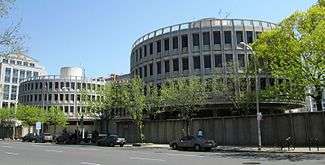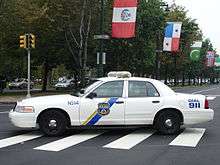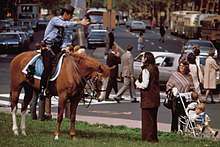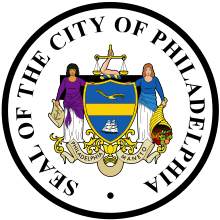Philadelphia Police Department
| Philadelphia Police Department | |
|---|---|
 | |
 | |
 Flag of the City of Philadelphia | |
| Abbreviation | PPD |
| Motto | Honor, Integrity, Service |
| Jurisdictional structure | |
| Operations jurisdiction | Philadelphia, Pennsylvania, United States |
| General nature | • Local civilian agency |
| Headquarters |
"The Roundhouse" nickname |
|
| |
| Police Officers |
6,400 (2014) 2013–2014 hiring 150 new officers (due to high retirements in FYs 2013–2015 in the police department). By FY2015 to have a sworn force of 6,525[1] |
| Agency executive | |
| Facilities | |
| multi small boats | 4 |
| helicopters | 2 ( two new ones on the way by July 2014) |
| Website | |
| Official Site | |
The Philadelphia Police Department (PPD or Philly PD) is the police agency responsible for law enforcement and investigations within the City of Philadelphia, Pennsylvania. The PPD is one of the oldest municipal police agencies [2], fourth largest police force[3] and sixth largest non-federal law enforcement agency in the United States. Since records were first kept in 1828, at least 270 PPD officers have died in the line of duty.
Present day

The PPD employs over 6,400 sworn officers and over 800 civilian personnel,[4] and patrols an area of 369.4 km² (142.6 mi²) with a population of almost 1.5 million. The department is subdivided into 21 patrol districts, and like many other large municipal police forces, it incorporates many special units such as a K-9 squad, SWAT, bomb squad, community relations unit, and marine unit. The highest-ranking officer is Commissioner Richard Ross.
Organization
The head of the PPD is the commissioner, who is appointed by the mayor. The current commissioner is Richard Ross (2016 – Present). Under the commissioner are two three-star deputy commissioners. The First Deputy Commissioner heads Field Operations. The Deputy Commissioner and Chief Administrative Officer heads Organizational Services, Strategy, and Innovation.
The Office of Field Operations is headed by the three-star First Deputy Commissioner of Field Operations, currently Myron Patterson (2016 – Present). The force comprises two commands, Patrol Operations and, Specialized Operations and Homeland Security; each command is headed by a two-star Deputy Commissioner. The Specialized Operations and Homeland Security command is headed by a two-star Deputy Commissioner, currently Dennis Wilson, and divided into two bureaus, Specialized Investigations and Homeland Security Bureau; each is headed by a chief inspector and further subdivided into several units.
The Office of Organizational Services, Strategy, and Innovation is headed by the three-star Deputy Commissioner and Chief Administrative Officer, currently Christine Coulter (2016 – Present).
Patrol Operations is headed by a two-star Deputy Commissioner of Patrol Operations, currently Joseph Sullivan, who oversees both the patrol and detective units. Patrol Operations is divided into two regional commands, Regional Operations Command (North) and Regional Operations Command (South). Each regional command is headed by a chief inspector, and is subdivided into three divisions (ROC-North: East, Northwest, Northeast; ROC-South: Central, Southwest, South). Each division is headed by an inspector.[5] A division comprises three or four districts; there are 21 patrol districts in all, and each district is headed by a captain. Each district is subdivided into three or four police service areas (PSA's), each headed by a lieutenant, for a total of 64 PSA's citywide.[6]
In January 2013, Commissioner Ramsey announced changes to the command structure of the department lowering the number of deputy commissioners from 9 to 6. Ramsey only replaced one of the deputies who was promoted from staff inspector of the Internal Affairs Bureau to deputy commissioner of the Office of Professional Responsibility.

Mounted units

The beginnings of the mounted unit can be traced to the Fairmount Park Mounted Guard created in 1867. In 1889 the Philadelphia Police Mounted Patrol Unit was established. The Philadelphia Police unit survived until 1952, however, the Fairmount Park unit would be used for parades and crowd control measures. The Fairmount Park Mounted Guard became the Fairmount Park Police in 1966, but maintained the same responsibilities. In 1972, Mayor Frank Rizzo found it unnecessary for taxpayers to fund two separate police departments, and merged the Fairmount Park Police into the Philadelphia Police, creating the Park Division. The mounted unit was once again used to patrol the streets of Philadelphia. The mounted unit survived to celebrate 100 years in 1989, but was disbanded in 2004 due to budgetary cuts by Mayor John F. Street's administration. On July 18, 2008, Philadelphia Police Commissioner Charles H. Ramsey confirmed that plans are in the works to recreate the mounted unit.[7] The Philadelphia Inquirer again reported on June 2, 2009, that Ramsey hoped to revive the unit once the city was in a better financial standing.[8] The continued recreation of the Mounted Unit took an additional step forward on October 31, 2011, when the city announced plans to build a new facility for the unit in Fairmount Park.[9]
Ranks within the Philadelphia Police Department
| Title | Insignia | Uniform Shirt Color | Type of Rank |
|---|---|---|---|
| Police Commissioner | Appointed by the city's managing director with the approval of the mayor | ||
| First Deputy Police Commissioner | Appointed by the city's managing director with the approval of the mayor | ||
| Deputy Police Commissioner 2-Star | Appointed by the city's managing director with the approval of the mayor | ||
| Deputy Police Commissioner 1-Star | Appointed by the city's managing director with the approval of the mayor | ||
| Chief Inspector | Civil service rank | ||
| Inspector | Civil service rank | ||
| Staff Inspector | Civil service rank | ||
| Captain | Civil service rank | ||
| Lieutenant | Civil service rank | ||
| Sergeant | Civil service rank | ||
| Corporal | Civil service rank | ||
| Police Officer | Civil service rank | ||
| Police Officer Recruit |
Description
To be promoted in the Philadelphia Police Department, a police officer must finish his first year in the department. Then, when the next corporal or detective test is announced, they are eligible to take the test. Philadelphia PD Test for corporal and detectives is a written multiple choice test, lasting two to three hours. Also part of an officer's score is based on seniority.[10]
The ranks of corporal and detective have the same pay grade, but have different functions. Corporals are "operations room supervisors" and are responsible for overseeing a patrol district's operations room, or a special unit's operations; i.e., ensure that reports are submitted accurately and in a timely manner, etc. Only rarely do corporals work the street. A corporal must have a minimum of a year's experience as a police officer.
Sergeants command a squad of officers, making assignments to beats, assigning traffic details, helping to supervise the radio room, commanding Marine Unit patrol boats and performing other similar tasks. When assigned to the detective bureau, a sergeant interviews suspects and witnesses, assigns detectives to cases and investigates clues, among other duties. Sergeants must have a minimum of two years experience as a police officer, or a year's experience as a corporal or detective.
The rank of lieutenant is the first executive supervisory rank. Lieutenants command an assigned area in a police district or a specialized unit, such as a traffic unit. If assigned as a detective, a lieutenant supervises an investigation. Lieutenants must have a minimum of one year's experience as a sergeant.
Captains either command police districts or direct the activities of a specialized unit. When assigned as a detective, a captain organizes and directs surveillance activities and police raids, prepares cases, interviews and interrogates suspects and testifies in court. Captains must have a minimum of one year's experience as a lieutenant.
Staff inspectors are usually departmental administrative officers, serving on the police Command Staff under a commissioner or deputy commissioner. They are generally assigned to inspect police divisions, districts and units, evaluate police practices, equipment and personnel, and make recommendations for improvement where necessary; however, they may also command units and divisions. Staff Inspectors must have a minimum of one year's service as a captain.
Inspectors are senior executive officers who typically command divisions and supervise officers under their command during any major police action, disaster or emergency. Inspectors must have a minimum of one year's service as a staff inspector or captain.
Chief inspectors are senior departmental administrative officers who either command bureaus within the department or who inspect police divisions, districts and units, evaluate police practices, equipment and personnel, and make recommendations for improvement where necessary. Chief inspectors must have a minimum of one year's service as a staff inspector or inspector.
Deputy commissioners and above are appointed by the city managing director with mayoral approval, not by the city civil service. Deputy commissioners are usually in charge of a regional command.
The two first deputy commissioners head the Office of Field Operations and the Office of Organizational Accountability.
The commissioner is appointed by the city managing director with mayoral approval, and is in charge of the entire department.[11]
Detectives
Detectives are part of the Detective Bureau, and may be assigned to Divisional Detective Units, or specialized units like Homicide, Organized Crime/Intelligence, Special Victims Unit, Gun Permits Unit and Background Investigation. The commanding officer of a detective division reports to the Inspector of Detective Bureau Headquarters. The ranking supervisor at Detective Bureau Headquarters is the Chief Inspector of the Detective Bureau. Detectives are not considered supervisory personnel, they are a civil service rank of their own and take orders from a sergeant. There are also police officers who serve in an investigative capacity, such as in the Juvenile Aid and Special Victims Units. Police officers who are assigned to the Detective Bureau are paid in the same pay scale as a police officer assigned to patrol.
Unlike most law enforcement agencies, the Philadelphia Police Department Detective Bureau does not maintain the ranks such as detective sergeant or detective lieutenant, etc. The supervisors (Sergeant, Lieutenant & Captain) in the Detective Bureau can be transferred back to patrol, and are required to maintain a uniform. Also, unlike other departments such as NYPD and LAPD, Philadelphia Police Detectives do not have a uniform that can be worn during details or funerals. The prescribed attire of a Philadelphia Police detective is proper business attire. In the Philadelphia Police Department, the rank of detective can only be made by a civil service exam and there are no grade differentiations. This is in contrast to NYPD that has the ability to make field promotions to the rank of detective for an outstanding performance or circumstance.
Highest-ranking officer by year

Police Marshals
- John J. Keyser, 1850–1853
- John K. Murphy, 1853–1855
Chiefs of Police
- Samuel G. Ruggles, 1855–1867
- St. Clair A. Mulholland, 1867–1872
- Kennard Jones, 1872–1879
- Samuel L. Given, 1879–1884
- James Stewart, 1884–1887
- James Lamon, 1887–1892
Superintendents of Police
- Robert Linden, 1892–1899
- Harry M. Quick, 1899–1904
- John B. Taylor, 1904–1912
- James Robinson, 1912–1920
- William B. Mills, 1920–1931
- Joseph E. Lestrange, 1931–1936
- James H. Malone, 1936–1937
- Edward Hubbs, 1937–1940
- Howard P. Sutton, 1950–1952
Police Commissioners
- Thomas J. Gibbons, 1952–1960
- Albert N. Brown, 1960–1962
- Howard Leary, 1962–1965
- Edward J. Bell, 1966–1967
- Frank L. Rizzo, 1967–1971 (first Italian American commissioner, later Mayor of Philadelphia)
- Joseph F. O'Neill, 1971–1980
- Morton B. Solomon, 1980–1984
- Gregore J. Sambor, 1984–1985
- Robert F. Armstrong, 1985–1986 (interim)
- Kevin M. Tucker, 1986–1988 (First commissioner from outside the police department since the 1920s)[12]
- Willie L. Williams, 1988–1992 (first African American commissioner, later chief of the LAPD)
- Richard Neal, 1992–1998
- John Timoney, 1998–2002 (formerly a police consultant)
- Sylvester Johnson, 2002–2008
- Charles H. Ramsey 2008–2015
- Richard Ross Jr. 2016–present
Districts
The following is a list of districts that the Philadelphia Police serve:[13]
East Division
25th District
- Station: 3901 Whitaker Ave., Philadelphia, PA 19124
- Commander: Captain Javier Rodriguez
24th District
- Station: 3901 Whitaker Ave., Philadelphia, PA 19124
- Commander: Captain Steven Clark
26th District
- Station: E. Girard Ave and Montgomery Ave., Philadelphia, PA 19125
- Commander: Captain Krista Dahl-Campbell
Northwest Division
5th District
- Station: Ridge Ave and Cinnaminson St., Philadelphia, PA 19128
- Commander: Captain John Moroney
39th District
- Station: 2201 W. Hunting Park Ave., Philadelphia, PA 19140
- Commander: Captain Anthony Ginaldi
35th District
- Station: N Broad St and Champlost St., Philadelphia, PA 19141
- Commander: Captain Ernest Ransom
14th District
- Station: Haines St and Germantown Ave., Philadelphia, PA 19144
- Commander: Captain John Hearn
Northeast Division
2nd District
- Station: Harbison Ave. and Levick St., Philadelphia, PA 19149
- Commander: Captain Thomas McLean
7th District
- Station: Bustleton Ave. and Bowler St., Philadelphia, PA 19115
- Commander: Captain Michael Gormley
8th District
- Station: Academy Rd. and Red Lion Rd., Philadelphia, PA 19154
- Commander: Captain Adam Friedman
15th Dist.
- Station: Harbison Ave and Levick St., Philadelphia, PA 19149
- Commander: Captain Anthony Luca
Central Division
6th District
- Station: 235 N 11th St., Philadelphia, PA 19107
- Commander: Captain John O'Hanlon
9th District
- Station: 401 N. 21st St., Philadelphia, PA 19130
- Commander: Captain Robert Ritchie
22nd District
- Station: 17th St and Montgomery Ave., Philadelphia, PA 19121
- Commander: Captain Kpana Massaquoi
Southwest Division
19th District
- Station: 61st St and Thompson St., Philadelphia, PA 19151
- Commander: Captain John Stanford
18th District
- Station: 55th St and Pine St., Philadelphia, PA 19143
- Commander: Captain Gregory Riley
16th District
- Station: 39th St and Lancaster Ave., Philadelphia, PA 19104
- Commander: Captain Jarreau Thomas
12th District
- Station: 65th St. and Woodland Ave., Philadelphia, PA 19142
- Commander: Captain DeShawn Beaufort
South Division
1st District
- Station: 24th St. and Wolf St., Philadelphia, PA 19145
- Commander: Captain Louis Campione
3rd District
- Station: 11th St and Wharton St., Philadelphia, PA 19147
- Commander: Captain Frank Milillo
17th District
- Station: 20th St and Federal St., Philadelphia, PA 19146
- Commander: Captain Michael O'Donnell
Demographics
The PPD's officers are and have been of many ethnicities. A large number of Irish Americans have been PPD officers since the 1850s.
- Male: 70%
- Female: 30%
- White: 55.6%
- African-American/Black: 36.4%
- Hispanic: 6.5%
- Other: 1.5%
Bureaus
- Special Operations
- Patrol
- Narcotics
- Detective
- Training
- Administration
- Staff Services
- Internal Affairs
- Intelligence
- Highway
Awards and honors
Decorations
- Sgt. Robert F. Wilson III Commendation for Valor
- Commendation for Bravery
- Commendation for Heroism
- Commendation for Merit
- Commendatory Citation
- RNC Service Ribbon
- Military Service Ribbon
George Fencl Award
The George Fencl Award, named in honor of Philadelphia Police Officer George Fencl, is given by the Daily News to a Philadelphia Police Officer who exemplifies compassion, fairness, and civic commitment. The award was first given in 1986.[14]
| Year | Rank | Name | District/Division |
|---|---|---|---|
| 1986 | Captain | David Morrell | 26th District, Commanding Officer |
| 1987 | Officer | Wiley L. Redding | 35th District, Community Relations |
| 1988 | Officer | Joe Donato | 19th District |
| 1989 | Captain | Al Lewis | 22nd District, Commanding Officer |
| 1990 | Lieutenant | Jose Manuel Melendez | East Division, Community Interaction Task Force |
| 1991 | Captain | George Fenzil | Traffic Unit, Commanding Officer |
| 1992 | Lieutenant | Stephen Johnson | Police Conflict-Prevention and Resolution Unit, Commanding Officer |
| 1993 | Officer | Edwin "Bo" Diaz | 26th District, Community Relations |
| 1994 | Captain | Arthur Durrant | 26th District, Commanding Officer |
| 1995 | Officer | James Perkins | 2nd District |
| 1996 | Officer | Joseph Dembeck | 14th District |
| 1997 | Officer | Brenda Robinson-Stowe | 16th District, Mounted Officer |
| 1998 | Captain | William Colarulo | 25th District, Commanding Officer |
| 1999 | Officer | Bernard Turner | 22nd District |
| 2000 | Chief Inspector | Dexter Green | Special Operations Unit, Commanding Officer |
| 2001 | Deputy Commissioner | Sylvester Johnson | Patrol, Narcotics, Detectives, and Special Operations, Commanding Officer |
| 2002 | Captain | William Fisher | Civil Affairs Unit, Commanding Officer |
| 2003 | Officer | Ruth McNatte | 16th District, Community Relations |
| 2004 | Chief Inspector | James Tiano | Community Affairs Bureau, Commanding Officer |
| 2005 | Officer | Darlene Chapman-Cummings | Anti-Drug Program: DARE |
| 2006 | Officer | AnnaMae Law | 26th District |
| 2007 | Sergeant | Kimberly Byrd | Chief of Staff |
| 2008 | Captain | Kevin Bethel | 17th District, Commanding Officer |
| 2009 | Officer | Adrian Hospedale | 12th District |
| 2010 | Officer | Richard "Butch" Riddick | 12th District |
| 2011 | Officer | Joseph Young | 12th District, Community Relations |
Notable events
- 1881, the Philadelphia Police Department hired its first African-American police officer.
- 1887, the police department was put under control of the city's Department of Public Safety. Two years later, the PPD inaugurated its mounted patrol, which was disbanded in 2004 but restored in 2011.[15]
- 1906, the motorcycle was introduced to the Philadelphia police.
- 1939, radio-installed patrol cars were put into use.
- 1964, a race riot broke out in North Philadelphia, calling every police officer in the city to duty.[16]
- 1970, a well publicized raid of the Black Panther Party occurs.[17][18] During the weekend of 29–30 August 1970, seven Philadelphia policemen were shot during widespread racial tension.[19]
- 1974, the Pennsylvania Crime Commission's "Report On Police Corruption And The Quality Of Law Enforcement In Philadelphia" concluded "The commission found that police corruption in Philadelphia is ongoing, widespread, systematic, and occurring at all levels of the police department. Corrupt practices were uncovered during the investigation in every police district and involved police officers ranging in rank from policeman to inspector. Specific acts of corruption involving improper cash payments to the police by gamblers, racketeers, bar owners, businessmen, nightclub owners, after-hours club owners, prostitutes, and others are detailed in the report. More than 400 individual police officers are identified by first name, last initial, and badge or payroll number as receiving improper payments in terms of cash, merchandise, sexual services, or meals." [20]
- 1979, the department reached its peak size at approximately 8,500 officers.
- 1985, a PPD helicopter bombed the MOVE compound, killing eleven residents of the house (five of them children) and burning about 65 nearby houses. This was the only time an American police department had used bombs on suspects until July 7, 2016, when the Dallas Police Department ended a standoff by using a ground-based robot to detonate C-4 on a suspect during the 2016 shooting of Dallas police officers.
- 1996, Lauretha Vaird becomes the first female PPD officer to be killed in the line of duty.
- 2000, Thomas Jones was beaten while wounded by more than one dozen law enforcement officers.[21]
- 2012, the PPD's education and/or experience requirements were increased to include at least one of four new options, including 60 college credits.[22]
- 2016, the PPD dropped the 60 credit requirement.
Notable investigations
- 1894-95, Detective Frank P. Geyer investigated H. H. Holmes, one of America's first serial killers who confessed to killing twenty-seven men, women, and children, some of which were later determined to be alive. Holmes killed his business partner, Benjamin Pitezel, in Philadelphia and later killed three of Pitezel's young children (two in Irvington, and one in Canada). Detective Geyer is credited with finding the bodies of the three children after a cross-country, international investigation.[23][24]
- 1981, PPD officer Daniel Faulkner was fatally shot by Mumia Abu-Jamal (né Wesley Cook) while performing a routine traffic stop of the latter's brother, William Cook. A jury convicted Abu-Jamal, a former Black Panther Party member, of first degree murder. He was sentenced to death in 1982, but in 2011 prosecutors said they would drop their pursuit of his execution and agreed to accept de facto life imprisonment without parole. The incident, subsequent trial and Abu-Jamal's conviction remain controversial in the US and around the world.
- 1999, serial killer Gary Heidnik was executed by lethal injection. Heidnik kidnapped, tortured and raped six women and kept them prisoner in his Philadelphia basement. A jury convicted Heidnik of the first degree murders of two of the women and sentenced him to death.[25]
- 2001, American Ira Samuel Einhorn, a.k.a. "The Unicorn Killer" (born May 15, 1940), was extradited from France back to Philadelphia to stand trial for the 1977 murder of Holly Maddux. Einhorn was an outspoken activist in the 1960s and '70s. In 1981, Einhorn fled to Europe to avoid the trial. In 1993, Einhorn had a trial in absentia and was convicted of first degree murder. In 2002, he was retried and again convicted. Einhorn was sentenced to life in prison without parole.[26][27]
- 2012, Antonio Rodriguez,[28] a.k.a. "The Kensington Strangler", received three life sentences for murdering three drug-addicted prostitutes in 2010.[29] The PPD convinced Rodriguez to confess after arresting him.[30]
- 2013, a federal jury convicted drug lord Kaboni Savage and his sister, Kidada, of orchestrating the 2004 firebomb murders of a witness's six family members and of conspiring to participate in a violent drug enterprise. The jury convicted Kaboni of 12 murders in total and he was later sentenced to death.[31][32]
Officers who died on duty
Over 260 Philadelphia Police Department officers have died on duty.[33]
See also
- Criminal Justice Center (Philadelphia)
- List of law enforcement agencies in Pennsylvania
- 39th District corruption scandal— "a persistent pattern of brutality and corruption among a cadre of Philadelphia Police Department officers, primarily from the Department's 39th District"
- Philadelphia Fire Department
- Philadelphia Highway Patrol
- Ron Previte Philadelphia mobster and former policeman.
- Frank Geyer Philadelphia police detective (employed 1876-1903) best known for his investigation of H. H. Holmes, one of America's first serial killers.
References
- ↑ "Teen mob attacks: Seeking loot and attention". Retrieved August 7, 2011.
- ↑ "How the U.S. Got Its Police Force". Time. Retrieved 2018-03-27.
- ↑ "ABOUT US". phillypolice.com. PPD. Retrieved 2015-03-17.
- ↑ "Home - About Us". Philadelphia Police Department. Retrieved 2015-03-15.
- ↑ "Senior Staff | 17th Police District". 17thppd.org. Archived from the original on October 4, 2013. Retrieved 2013-11-07.
- ↑ "Philadelphia Police Department Command Chart" (PDF). Phillypolice.com. 2013-11-06. Retrieved 2014-11-13.
- ↑ Hanson, Tony (July 18, 2008). "Phila. to Rebuild Its Mounted Police Unit". KYW Newsradio. Archived from the original on January 15, 2009. Retrieved July 18, 2008.
- ↑ Gambardello, Joseph (June 2, 2008). "Philly police Segway patrols ready to roll". The Philadelphia Inquirer. Retrieved June 3, 2008.
- ↑ Clark, Vernon (October 31, 2011). "City to build $1.4 million home for police mounted unit". The Philadelphia Inquirer. Retrieved October 31, 2011.
- ↑ "Careers - Overview | Philadelphia Police Department". Phillypolice.com. Retrieved 2013-11-07.
- ↑ Philadelphia, Office of Human Resources - City of. "Phila.gov - Human Resources - Job Class Specifications". www.phila.gov. Retrieved July 30, 2018.
- ↑ Warner, Bob (2012-06-19). "Former police commissioner Tucker dies". The Philadelphia Inquirer. Retrieved 2012-07-03.
- ↑ Philadelphia Police Department Website, Retrieved on 2015.11.05
- ↑ Glover, Sarah J. (June 3, 2010). "Fencl Award winners over the years". Philly.com. Philadelphia, PA, US: Philadelphia Daily News. Retrieved June 3, 2010.
- ↑ "Restored Phila. mounted police unit gets back in the saddle". philly.com. The Philadelphia Inquirer. Retrieved 2015-01-28.
- ↑ Doing No Good Time Magazine
- ↑ Bolling, D."He's Seen It All", CityPaper.net August 22, 2002
- ↑ "85th Birthday Celebration for Elwood P. Smith". Phillynewmedia.com. Retrieved 2013-11-07.
- ↑ Gibbons, Jr, Thomas J (9 July 2016). "Ex-cop: I know the pain of Dallas - I was shot in 1970 amid racial turmoil". Inquirer. Retrieved 10 July 2016.
- ↑ "Report On Police Corruption And The Quality Of Law Enforcement In Philadelphia". National Institute of Justice.
- ↑ Bishop, Tom. "Police beating in Philadelphia captured on videotape". Retrieved July 30, 2018.
- ↑ "Qualifications and Requirements". phillypolice.com. PPD. Retrieved 2015-03-17.
- ↑ Crighton, JD (2017). Detective in the White City: The Real Story of Frank Geyer. Murrieta, CA: RW Publishing House. pp. 136–208. ISBN 978-1-946100-02-3.
- ↑ Geyer, Frank P. (1896). The Holmes-Pitezel case: a history of the greatest crime of the century and of the search for the missing Pitezel children. Philadelphia, PA: Publishers' Union.
- ↑ "Horrors' Killer Gets His Wish Victims' Kin Watch As Gary Heidnik Gets Lethal Injection". philly.com. Philadelphia Daily News. Retrieved 2015-01-29.
- ↑ "Ronnie Polaneczky: The Ira Einhorn Interview". philly.com. Philadelphia Daily News. Retrieved 2015-03-17.
- ↑ "KNIGHT: Earth Day co-founder written out of history". The Washington Times. Retrieved 2015-03-17.
- ↑ "Experts: Kensington Strangler Is Classified as 'Sexual Serial Killer'". abcnews.go.com. ABC. Retrieved 2015-03-19.
- ↑ "3 life sentences for man in Kensington stranglings". philly.com. The Philadelphia Inquirer. Retrieved 2014-11-24.
- ↑ "'Kensington Strangler' suspect Antonio Rodriguez: I had sex with victims after they were dead". New York Daily News. Retrieved 2014-01-28.
- ↑ "Drug Kingpin Kaboni Savage and Sister Kidada Convicted of Arson Murders". fbi.gov. FBI. Retrieved 2014-12-02.
- ↑ "Death penalty for Kaboni Savage". philly.com. The Philadelphia Inquirer. Retrieved 2014-12-02.
- ↑ "Memorial at PhillyHeroes.org". Archived from the original on November 28, 2016. Retrieved July 30, 2018.
External links
| Wikimedia Commons has media related to Philadelphia Police Department. |
- Official website
- Philadelphia Police Blog
- Philadelphia Police Facebook
- Philadelphia Police Twitter
- Philadelphia Police Department's channel on YouTube
- Philadelphia Police Department Exam
- Honoring All Fallen Members of the Philadelphia Police Department
- Philadelphia Police Corruption Today via CBS Philly
- History of City of Philadelphia and its Police Department
